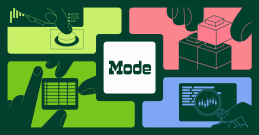Mode CEO Gaurav Rewari On Why the Future of Modern BI Is Now and at Mode

Gaurav Rewari, CEO
December 17, 2022
NaN minute read

The path that led me to Mode
I’ve been in data and analytics longer than I care to admit and have had a chance to witness first hand several key phases of our industry’s evolution. Before we get into history lessons and the future, let me tell you about the path that led me here to Mode.
Many moons ago I led products at a company called MicroStrategy that, along with Business Objects & Cognos, really came to define business intelligence in its first incarnation.
Later, when I had responsibility for analytics products at Oracle, we added Siebel Analytics and Hyperion, and saw our BI portfolio expand beyond the underlying platform to include prebuilt business analytics applications for the sales, marketing and finance functions.
And, most recently, at Numerify, I had the chance to lead the team that brought to market similar business analytics applications for the IT operations & development organizations, one of the first cloud analytics applications built entirely on the modern data stack.

Watch a product tour of Mode
Curious about how Mode works? Sit back and watch the video—no reps ;)
Whether all this time in this field makes me an old BI hand or a glutton for punishment, I will let you decide. But what I can tell you, is that having witnessed the various disruptions in the business analytics market over the past couple of decades, the reason I joined Mode was that I think what we are looking at here is one of the most exciting industry shifts that I have seen in all my years in data and analytics.
Back as early as the 2000s, it was well accepted that organizations needed to embrace fact-based decision-making, provide timely insights—descriptive and predictive—to all stakeholders regardless of their technical proficiency, and with all types of data collected from all four corners of the business. The challenge itself was well understood.
We have inched towards this in fits and starts through innovations such as Relational OLAP, semantic layers, and ELT to name but a few, but despite these technical innovations, for the vast majority of organizations, the goal of pervasive decision support—allowing all employees to “know what you you need to know, to do what you need to do”—has remained largely out of grasp.
Everyone is investing in data teams—and putting them at the center
But in the last 12 months, as I have spoken to Mode’s customers and heard their stories I feel a strong sense of mounting excitement—that the moment of significantly broader adoption is now upon us.
A lot of Mode’s customers today are the who’s who of digital natives—companies that live or die by how well they use their data—think Doordash, Lyft, Shopify, Zillow, Figma, Canva, to name a few. In fact, for the first time in my life, my 14-year-old daughter actually thinks I am doing something cool because she knows the names of the companies that are our customers!
But all jokes aside, as I spent time with these customers, I learned more about how they were using Mode’s platform, how technical analysts and non-technical business users were actively collaborating to answer questions in minutes and hours, not days and weeks.
And I saw the absolutely central role that the data team was playing in making this vision a reality across almost 700 customers. There is hardly a company started in the last 10 years, especially one with a digital channel, that doesn’t put in place a data team in its early days: a team with technical skills and an appreciation for the business; a team whose charter rapidly expands to providing insights to all functions of the business; a team with a seat at the table.
My conversations with Mode’s customers showed me how the central mission of reducing time to insights was being brought to life by this partnership between the data team and business users—multiple modes of analysis, code-first and code-free paradigms, unified in a single platform.
Most importantly, though, these customer conversations showed me the emerging contours of a modern BI platform, one that has the data team as its living, beating heart.
Download now

How to Lead From the Center: A Guide for Data Leaders
Learn how to unlock a trusted data experience across your org.
Data is seeing a change of epic scale and Mode is meeting that scale now
“The science fiction novelist William Gibson talks about how the future is already here, it is just very unevenly distributed.”
In a similar vein, it was clear to me from my early customer conversations that these digital natives were using Mode to provide BI today in a way that the rest of the world would tomorrow. But the question of “when” still remained. What is it that would unlock more universal adoption?
The answer to that became increasingly clear to me in subsequent customer conversations not just with digital natives, but also larger Global 2000 organizations. These companies talked to us about their data and analytics strategy and the stunning rate at which they were cutting over increasingly more important analytical workloads to the modern data stack. I knew then that I had the answer to my question of when. The when is now.
The modern data stack with the cloud data warehouse at its core is the most significant architectural shift that I have seen in 2 plus decades in our industry, and I think people don’t fully appreciate the scale of what is happening here. Sure, there are cool innovations such as the separation of storage and compute in the persistence layer, but the fundamental point is that the economics of storing all your data in one place has changed forever.
Not too long ago there were just a few hundred companies that could afford to have atomic data from all function areas in a single warehouse kept current and available for analysis. Today, that is within reach for any company for a few thousand dollars a month as a fully managed service. As a result, the number of companies that can, in principle, analyze all their data across all functional areas, at the most granular level, has increased by multiple orders of magnitude. This is a change of epic scale.
“The number of companies that can, in principle, analyze all their data across all functional areas, at the most granular level, has increased by multiple orders of magnitude.”
And so, at Mode, we believe that the time has now come for a modern BI platform that is purpose-built for the modern data stack. A modern BI platform that serves the needs of the entire business with the data team at its core; a modern BI platform that creates a collaborative experience for all stakeholders to analyze, explore, share and present insights.
Make no mistake: this is a once-in-a-generation transformation. One that will forever clear the path from data to action. And it is happening now.
You’ll see this come to life in the new products that will fundamentally change the way you and your cross-functional partners work in Mode. From reusable datasets that require no code for data exploration to Mode’s integration with dbt’s Semantic layer - the future is already here at Mode!
Get our weekly data newsletter
Work-related distractions for data enthusiasts.



